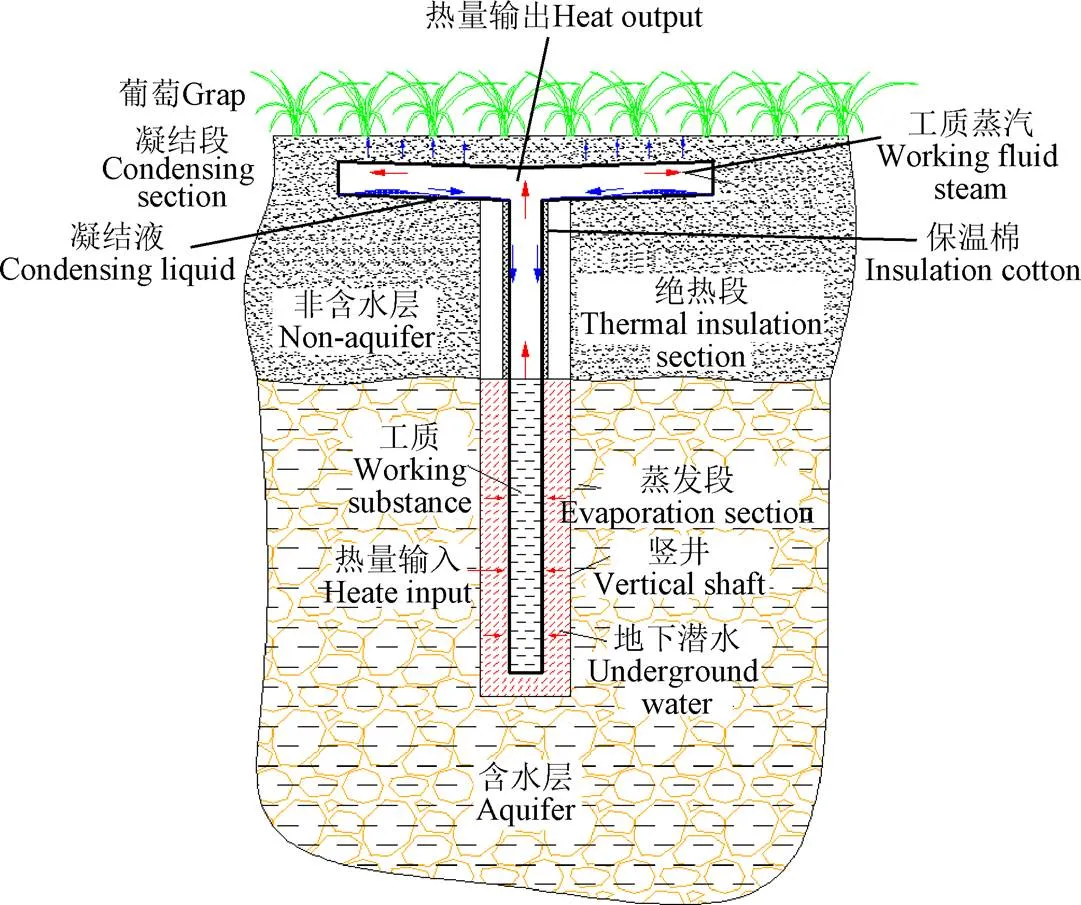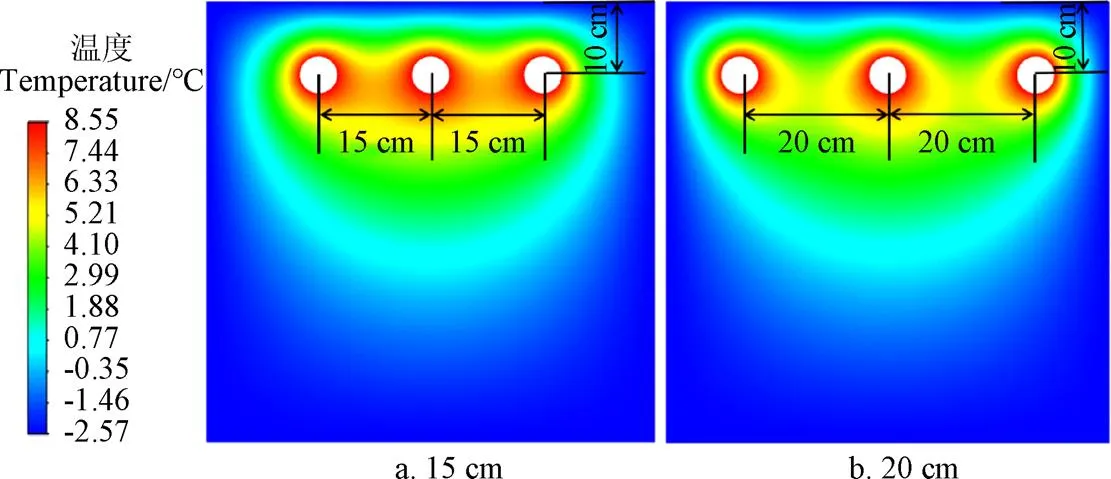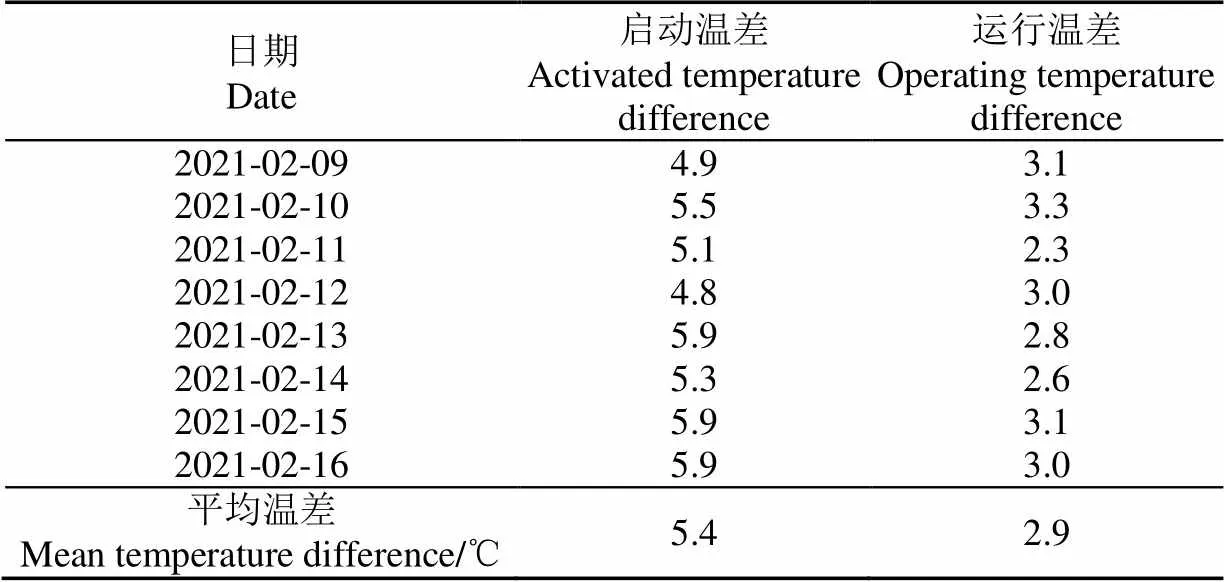重力热管供热对葡萄越冬根区的增温效应
邓改革,何建国,李建设,康宁波
•农业生物环境与能源工程•
重力热管供热对葡萄越冬根区的增温效应
邓改革,何建国,李建设※,康宁波
(宁夏大学土木与水利工程学院,银川 750021)
葡萄是宁夏特色优势产业,越冬冻害是制约贺兰山东麓葡萄产业可持续发展的关键问题之一。为解决葡萄越冬根部冻害问题,该研究设计了利用浅层地下水地热能进行葡萄根区土壤增温的重力热管系统;通过数值模拟解析不同间距条件下重力热管温度场影响范围及分布规律,通过现场试验研究重力热管的工作特性及对土壤的增温特性。结果表明:土壤温度场以重力热管为中心向四周扩散,热管中温影响区水平方向直径为30.8 cm,竖直方向直径为32.8 cm;在埋深10 cm,相邻热管间距15 cm条件下热管周围温度场部分区域重合,温度场分布均匀;试验期间试验组土壤温度较对照组平均升高7.0 ℃,增温效果明显;重力热管正常运行期间蒸发段凝结段之间最大温差为3.7 ℃,蒸发段内最大温差为1.0 ℃,绝热段内最大温差为0.2 ℃,表现出了良好的等温性;热管平均启动温差为5.4 ℃,平均运行温差为2.9 ℃;研究结果将为解决葡萄根区冻害问题以及探索浅层地热能利用新途径提供理论依据和技术支撑。
温度;土壤;传热;重力热管;土壤增温;数值模拟
0 引 言
葡萄是宁夏特色优势产业,截至2022年底,宁夏酿酒葡萄种植面积达到388.7 km2。贺兰山东麓是中国新兴的优质酿酒葡萄种植区,被称为中国的“波尔多”,具有日照充足、热量丰富、降水量少、昼夜温差大等优势,被认为是世界上最适合葡萄种植酿造葡萄酒、生产高端葡萄酒黄金地带之一[1-2]。
在中国北方,极端最低气温低于−15 ℃的地区种植的葡萄需要埋土越冬,否则就会发生越冬冻害或抽干。贺兰山东麓地区是典型的大陆性气候,冬季寒冷干燥,极端气温可低至−30 ℃,对葡萄的安全越冬造成极大威胁[3]。在葡萄越冬冻害防御方面,科研人员开展了大量的研究工作[4-5],例如提出应用抗寒嫁接苗[6]、“沟栽法”建园、按规程埋土[7-8]、材料隔离覆盖[9-10]等防冻措施,其中埋土覆盖措施是最常见、应用最普遍的防寒措施[8]。传统的埋土方式,由于土取自行间,在葡萄密植情况下,取土后根系土壤覆盖层变薄,葡萄在越冬过程中尽管枝蔓不受冻害,但根系难抵低温,根系冻害仍普遍发生[11],因此解决葡萄越冬冻害问题亟需创新的技术和方法。
热管是一种高效的能量转换装置[12-13],它利用流体的潜热[14-15],通过在密封容器中蒸发和冷凝的方式将热量从一个地方转移到另一个地方[16-17]。热管能够以较小的温降实现大热流的远距离传输[18-19],因此在热能存储系统[20-22]、热管理[23-24]、道路融雪[25-26]等许多领域都有广泛的应用[27]。
本文以贺兰山东麓越冬葡萄为研究对象,采用主动增温技术,借助重力热管将地下水热量转移至葡萄根区土壤,解析热管周围温度场变化规律,评价热管工作性能及根区增温效果,进而为葡萄安全越冬提供理论依据和科学决策支持。
1 材料与方法
1.1 试验装置工作原理
热管从地下水中吸收热量并转移至葡萄根区土壤,使土壤不冻结。文中土壤重力热管加热系统采用“T型”结构,蒸发段位于竖井的地下水中,保温段位于浅层土壤中,水平凝结段埋在葡萄根区土壤中。“T型”热管的水平部分被设计成中间低、两侧高,以保证凝结液可以顺利地流回蒸发段,结构原理如图1所示。冬季地下水温度高于根部土壤,热管蒸发段工质沸腾吸热,工质蒸汽沿管道传至凝结段,随后气态工质在凝结段凝结为液态工质并释放出汽化潜热。凝结液在重力作用下回流至蒸发段,通过上述循环热管不断将热量从地下水转移至根部土壤,进而实现葡萄根系土壤增温,制作完成的重力热管如图2所示。
1.2 数值模拟试验设计
试验区域土壤白天接收太阳辐射温度升高,土壤储蓄热量;夜晚气温降低土壤温度高于气温开始向外释放热量,根部土壤与外界大气之间属于对流换热,重力热管凝结段管壁与周围土壤之间换热方式为热传导,二维模型见图3所示。

图1 重力热管的构成及工作原理示意图

图2 重力热管外观图

注:H为重力热管埋深,L为重力热管间距。
地表与外界空气以对流换热方式进行热交换,属于带内热源的对流换热第三类边界条件,在土壤表面处,地表与外界环境间换热方式为热对流,换热量大小计算式如下:

式中为地表空气间对流换热系数,W/(m2·K)。
凝结段重力热管单元均匀布置,温度场对称轴线处无热流传递可将其视为绝热边界,同时由于温度场对称性及两侧均无热量通过,属于绝热边界,则有:

在初始时刻,假设土壤的初始温度为0,即:
(,,0)=0(3)
土壤夜间无法接收太阳辐射,本研究主要为了获取夜间条件下重力热管在葡萄根区土壤增温特性,地表土壤与外界空气选取对流换热边界条件,换热系数根据对流换热公式计算,取值为4 W/(m2·K),经测定土壤的物性参数为:密度=1 900 kg/m3,导热系数=1.10 W/(m·K),比热容=1 500 J/(kg·K)。当地每年1月份平均气温最低,以1月份现场参数作为数值模拟的初始条件:其中距地表0~600 mm范围土壤平均温度为−2.57 ℃,根据现场实测数据,重力热管管壁平均温度为8.5 ℃,平均气温为−2.7 ℃。
1.3 土壤增温试验设计
试验组为直径50 mm铜管加工成的重力热管增温系统,对照组为普通地表土壤,不做任何处理;重力热管凝结段埋深要综合考虑多方面的影响:埋深过小,热管释放热量容易通过地表散失到空气中进而造成能量浪费,埋深过大则容易导致葡萄浅层根系受冻,前期预试验结果显示热管单元传热影响半径为15 cm左右,为了保证极端低温天气条件下地表附近葡萄根系不受冻害,保留一定安全余量,将热管凝结段埋深设定为10 cm;为了了解重力热管工作特性及土壤增温特性,分别在试验组重力热管蒸发段、绝热段、凝结段、凝结段相邻管中间土壤中以及对照组地表土壤中布置传感器来监测温度变化,具体传感器测温点布置如图4:重力热管蒸发段布置3个测温点(温度值分别为:1、2和3),传感器和热管蒸发段均布置在地下水位以下的含水层中,且间隔均匀布置;重力热管绝热段布置2个测温点(温度值分别为:4和5),位于地下水位以上的非含水层中;凝结段布置2个测温点(温度值分别为:E6和E7),在凝结段相邻管中间土壤中布置1个测温点(温度值为:8),在对照组土壤相同深度位置处布置1个测温点s,另外布置一个空气温度传感器测温点a用于监测气温变化。
试验中需要测定的项目包括重力热管蒸发段平均温度evp-E,℃;绝热段平均温度insu-E和凝结段平均温度con-E,℃。
evp-E可以通过式(4)计算。

insu-E可以通过式(5)计算。

con-E是凝结段平均温度,计算式如下:

注:文中数据单位为mm。6和7为凝结段测温点;8为蒸发段土壤测温点。
Note: The data unit in the text is mm. 6 and 7 are temperature measuring points of condensation section; 8 is soil temperature measurement point of evaporation section.
图4 热管测温点分布示意图
Fig.4 Schematic diagram of heat pipe temperature measurement point distribution
2 结果与分析
2.1 数值模拟试验结果分析
为了解单个重力热管单元在土壤中的传热特性,建立单重力热管单元传热模型,所选取模型宽高均为60 cm,重力热管单元距地表10 cm。
温度场模拟结果见图5所示,土壤温度场以热管为中心向四周扩散,根据温度高低可将温度场划分为4个区域:温度范围为5.0~8.50 ℃高温影响区Ⅰ,温度范围为0~5.0 ℃中温影响区Ⅱ,温度范围为−2.57~0 ℃低温影响区Ⅲ,温度场未受影响区域Ⅳ;最高温度出现在温度场区域Ⅰ凝结段管壁,温度为8.50 ℃;从管壁四周向外温度逐渐降低,在温度场区域Ⅳ温度降至最低为−2.57 ℃,该温度也是在一月份气象参数且无热管存在条件下土壤温度场的初始值;土壤中葡萄根系不受冻害的中温温度场Ⅱ影响范围在竖直方向直径为32.8 cm,水平方向直径为30.8 cm。
为了解相邻重力热管温度场的相互影响,建立3个重力热管单元模型,由前面分析可知热管单元在水平方向影响半径为15 cm,现将热管单元间距设定为15 cm,其温度场模拟结果见图6a所示。由图6a可知,3重力热管温度场稳定后,相邻热管单元温度场相互影响,高温影响区Ⅰ部分区域重叠,区域Ⅱ相互连通形成一更大范围中温影响区,热管上方距离地表4 cm平面区域温度场均匀,维持在4.10 ℃左右。

注:Ⅰ、Ⅱ、Ⅲ、Ⅳ分别表示热管的高温影响区,中温影响区,低温影响区及温度场未受影响区。
由此可知,热管单元间距为15 cm时,相邻热管间传热影响范围稍有重合,为节约成本,尝试将热管单元间距增大至20 cm,研究该热管间距下,热管单元间距对土壤温度场均匀性的影响,进而分析其温度场分布规律,结果见图6b。由图6b可知,当重力热管单元间距增大至20 cm后,高温影响区域Ⅰ重合部分较15 cm间距情况下明显减少,中温影响区Ⅱ相互连通形成一更大范围中温影响区,但热管上方4 cm区域温度场均匀性较15 cm间距情况变差。由此可知,增加热管单元间距虽然可以降低材料及加工成本,但是土壤温度场均匀性也相应变差;减小热管单元间距可以增加土壤温度场均匀性,但是增加了材料及加工成本。因此,热管单元间距的选取应该在保证土壤温度场均匀性的前提下适当增加其间距,综合分析本文中单元热管间距确定为15 cm。

图6 不同热管间距温度场模拟
2.2 土壤增温试验结果分析
2.2.1 观测期内重力热管传热特性分析
为了了解重力热管对葡萄根区的增温效应,在宁夏大学农科实训中心布置重力热管试验系统,现场试验从2020年11月16日开始到2021年3月16日结束,共持续120 d。
试验期间试验组和对照组温度场变化规律如图7所示。由图7可知,试验期间气温以天为周期波动,前50 d整体呈下降趋势,后期气温波动上升;对照组土壤温度变化趋势与气温变化趋势类似,但是土壤温度变化滞后于气温变化,该结论与前人的研究结果类似[28];试验组土壤温度8测点位于凝结段相邻热管中间土壤中,其温度主要由凝结段平均温度con-E决定,从图7可以看出两者温度变化趋势几乎同步,由于热量是由热管向土壤传递,因此凝结段热管温度高于相邻热管间土壤温度;热管持续将地下水中热量转移至葡萄根系土壤,试验组土壤温度明显高于对照组,试验期间试验组土壤温度8较对照组土壤温度s平均提升7.0 ℃,增温效果明显;试验期内重力热管蒸发段温度高于凝结段,平均温差为2.1 ℃,说明热管有良好的传热特性。基于此特性,热管蒸发段与凝结段具有类似的温度场变化规律:当外界气温降低时,葡萄根部土壤温度随之降低,热管凝结段向土壤释放热量增加而导致其温度下降,此时蒸发段向凝结段传递热量也增加,蒸发段温度随之下降;反之,当外界气温升高时,葡萄根部土壤温度随之升高,热管凝结段向土壤释放热量减少而导致其温度升高,此时蒸发段向凝结段传递热量也减少,蒸发段温度随之上升。

注:Tevp-E和Tcon-E分别为热管蒸发段和凝结段平均温度,℃。
2.2.2 重力热管轴向温度分布及启动特性分析
为研究重力热管轴向温度分布特征,现选取观测期内5个典型天气进行分析,分别是2020年11月21日下雪天,2020年12月2日阴天,2021年1月6日极寒天气,2021年1月12日晴天,2021年2月20日白天温度极高。轴向温度分布见表1所示。
重力热管正常运行期间蒸发段温度高于绝热段,绝热段温度高于凝结段,由表1分析可知,选取的5个典型天气除2021年2月20日外,重力热管均处于正常运行状态;重力热管正常运行期间蒸发段与凝结段最大温差为3.5 ℃,蒸发段内最大温差为1.0 ℃,绝热段内最大温差为0.20 ℃,热管表现出了良好的等温性。在试验观测后期的2021年2月20日白天温度达到了观测期内的最高值21.0 ℃,同时热管凝结段温度达到了12.2 ℃,该温度超过了蒸发段的温度,热管停止工作。

表1 重力热管轴向温度分布
注:Δmax为蒸发段与凝结段最大温差,℃。
Note:Δmaxis the maximum temperature difference between the evaporation and condensation section, ℃.
为进一步研究该重力热管的启动特性,对2021年2月9日至2月16日共计8 d的观测数据进行分析。由图8可知,随着试验后期气温回升,一天中有部分时间凝结段温度超过蒸发段,热管停止工作,其余时间随着气温降低凝结段温度也随之降低,当蒸发段凝结段温差达到一定数值后,热管又重新运行。热管蒸发段与凝结段温差Δ可作为判断热管是否处于工作状态的关键指标,根据传热学原理,当Δ降为0 ℃时,热管停止工作,当Δ增加到一定数值时,热管重新启动,该温差称为热管的启动温差,热管正常运行期间温差称为运行温差。由图8可知上述观测期内热管均处于间歇运行状态。对上述观测期内热管运行相关参数进行统计,见表2。通过表2可知,热管平均启动温差为5.4 ℃,平均运行温差为2.9 ℃。

注:ΔT为蒸发段与凝结段温差,℃。

表2 重力热管启动温差及运行温差统计
3 结 论
1)重力热管凝结段不同间距会影响其土壤中温度场分布规律,土壤中葡萄根系不受冻害的中温温度场影响范围在竖直方向直径为32.8 cm,水平方向直径为30.8 cm。
2)重力热管正常运行期间蒸发段和凝结段之间最大温差为3.5 ℃,等温性良好;试验组土壤温度较对照组平均提高7.0 ℃,增温效果明显,通过重力热管开发浅层地热能实现葡萄根区增温防冻的方法是可行的。
本研究旨在探索一种利用清洁可再生的浅层地热能来实现葡萄根区增温的方法,为解决葡萄根区冻害问题提供理论依据和技术支撑。然而影响热管传热特性及土壤增温特性的因素较多,如热管材质、管径、土壤导热系数以及不同蒸发段凝结段长度等,这些内容将在今后的研究中进一步丰富和深入。
[1] 丁琦. 宁夏典型酿酒葡萄抗寒机理研究[D]. 南京:南京信息工程大学,2020.
DING Qi. The Mechanism of Cold Resistant of Typical Wine Grape in Ningxia Province[D]. Nanjing: Nanjing University of Information Science &technology, 2020. (in Chinese with English abstract)
[2] 李欣,张光弟,李玉鼎. 简易埋土法在贺兰山东麓酿酒葡萄越冬防寒中的应用研究[J]. 北方园艺,2013,36(3):34-36.
LI Xin, ZHANG Guangdi, LI Yuding. Application study on the way of easy soil-burying for grapewine cold resistant at eastern foot of Helan Mountain in winter[J]. Northern Horticulture, 2013,36(3): 34-36. (in Chinese with English abstract)
[3] 李玉鼎,宋文章,宋长冰,等. 2009年黄羊滩、红寺堡等酿酒葡萄基地葡萄冻害调查报告[J]. 中外葡萄与葡萄酒,2010,34(11):35-37.
LI Yuding, SONG Wenzhang, SONG Changbing, et al. Investigative report on grape frost damage in huangyangtan, Hongsibao and other wine grape bases in 2009[J]. Sino-Overseas Grapevine & Wine, 2010, 34(11): 35-37. (in Chinese with English abstract)
[4] 胡悦,刘玉兰,郭晓雷,等. 保温棚对葡萄免埋土越冬防寒的作用[J]. 北方园艺,2020,43(19):52-56.
HU Yue, LIU Yulan, GUO Xiaolei, et al. Effects of heat preservation shed on cold protection of grape without burying soil[J]. Northern Horticulture, 2020,43(19): 52-56. (in Chinese with English abstract)
[5] 李树德,李兆寰. 不同防寒措施对葡萄树体生长与结果特性的影响[J]. 新疆农垦科技,2021,44(1):10-12.
[6] 李玉鼎,马成斌,李欣,等. 宁夏酿酒葡萄种植业可持续发展思考[J]. 中外葡萄与葡萄酒,2019,43(2):99-102.
LI Yuding, MA Chengbin, LI Xin, et al. Thoughts on sustainable development of wine grape planting industry in Ningxia[J]. Sino-Overseas Grapevine & Wine, 2019,43(2): 99-102. (in Chinese with English abstract)
[7] 刘素芹,宋云云,吕鸿松. 葡萄免埋土防寒越冬栽培技术[J]. 落叶果树,2021,53(2):60-61.
[8] 李从娟,王世杰,孙永强,等. 葡萄越冬防寒技术研究综述[J]. 沙漠与绿洲气象,2021,15(2):138-143.
LI Congjuan, WANG Shijie, SUN Yongqiang, et al. Overview of the grape protection techniques against the cold in winter[J]. Desert and Oasis Meteorology, 2021, 15(2): 138-143. (in Chinese with English abstract)
[9] 徐红雁. 双膜覆盖对葡萄安全越冬的影响分析[J]. 农业与技术,2021,41(6):145-148.
[10] 李鹏程,李铭,郭绍杰,等. 无胶棉覆盖葡萄越冬对根区土壤温度的影响[J]. 黑龙江农业科学,2012,34(12):39-41.
LI Pengcheng, LI Ming, GUO Shaojie, et al. Effect of glueless cotton covering on root region soil temperature in grapes[J]. Heilongjiang Agricultural Sciences, 2012,34(12): 39-41. (in Chinese with English abstract)
[11] 张亚红,平吉成,王文举,等. 宁夏酿酒葡萄不同埋土方式越冬效果的比较[J]. 果树学报,2007,23(4):449-454.
ZHANG Yahong, PING Jicheng, WANG Wenju, et al. Comparison of different soil - burry methods on the over - wintering of wine gr ape cultivars in Ningxia Autonomous Region[J]. Journal of Fruit Science, 2007,23(4): 449-454. (in Chinese with English abstract)
[12] YU F, QI J L, ZHANG M Y, et al. Cooling performance of two-phase closed thermosyphons installed at a highway embankment in permafrost regions[J]. Applied Thermal Engineering, 2016, 98: 220-227.
[13] HAN F L, CHEN L, YU W B, et al. Experimental study on heat transfer of upright pipes in cold regions[J]. Applied Thermal Engineering, 2017, 117: 17-23.
[14] Kim Y A, Kim J S A, Shin D H Aet al. Effects of hydrophobic and superhydrophobic coatings of a condenser on the thermal performance of a two-phase closed thermosyphon[J]. International Journal of Heat & Mass Transfer, 2019, 144:118706.
[15] ZHANG Y P, QU F F, CHEN Y, et al. Simulation optimization research of anti-freezing heat pipe for preheating fresh air in wellbore[J]. Earth and Environmental Science, 2021, 647(1): 12093.
[16] CEN J W, LI F, LI T L, et al. Experimental study of the heat-transfer performance of an extra-long gravity-assisted heat pipe aiming at geothermal heat exploitation[J]. Sustainability, 2021, 13(22): 12481.
[17] NIKOLAENKO Y, PEKUR D, SOROKIN M, et al. Experimental study on characteristics of gravity heat pipe with threaded evaporator[J]. Thermal Science and Engineering Progress, 2021, 26: 101107.
[18] DENG G G, KANG N B, HE J G, et al. An investigation of the performance of groundwater-based heat pipes in heating lawn systems[J]. Energy Conversion and Management, 2021, 244: 114492.
[19] SUN F R, YAO Y D, LI G Z, et al. Performance of geothermal energy extraction in a horizontal well by using CO2as the working fluid[J]. Energy Conversion and Management, 2018, 171: 1529-1539.
[20] 李洪,张曼. 被动调节模式环路热管型光伏光热系统性能分析[J]. 农业工程学报,2021,37(16):205-211.
LI Hong, ZHANG Man. Performance analysis of loop-heat-pipe type solar photovoltaic/thermal system under passive regulation operating mode[J]. Transactions of the Chinese Society of Agricultural Engineering (Transactions of the CSAE), 2021, 37(16): 205-211. (in Chinese with English abstract)
[21] 吴薇,夏曼,尹正宇,等. 蓄能材料对内插热管式太阳能热泵系统冬季性能的影响[J]. 农业工程学报,2020,36(5):226-232.
WU Wei, XIA Man,YIN Zhengyu, et al. Effect of energy storage materials on performance of solar heat pump system with inserted heat pipe in winter[J]. Transactions of the Chinese Society of Agricultural Engineering (Transactions of the CSAE), 2020, 36(5): 226-232. (in Chinese with English abstract)
[22] MAALEJ S, ZAYOUD A, ABDELAZIZ I, et al. Thermal performance of finned heat pipe system for Central Processing Unit cooling[J]. Energy Conversion and Management, 2020, 218: 112977.
[23] 张维蔚,王甲斌,田瑞,等. 热管式真空管太阳能聚光集热系统传热特性分析[J]. 农业工程学报,2018,34(3):202-209.
ZHANG Weiwei, WANG Jiabin, TIAN Rui, et al. Analysis of heat transfer characteristics for parabolic trough solar collector system with heat-pipe evacuated tube[J]. Transactions of the Chinese Society of Agricultural Engineering (Transactions of the CSAE), 2018, 34(3): 202-209. (in Chinese with English abstract)
[24] 王腾月,刁彦华,赵耀华,等. 微热管阵列式太阳能空气集热-蓄热系统性能试验[J]. 农业工程学报,2017,33(18):148-156.
WANG Tengyue, DIAO Yanhua, ZHAO Yaohua, et al. Performance experiment on solar air collection-storage system with phase change material based on micro heat pipe arrays[J]. Transactions of the Chinese Society of Agricultural Engineering (Transactions of the CSAE), 2017, 33(18): 148-156. (in Chinese with English abstract)
[25] WANG X Y, FAN H T, ZHU Y Z, et al. Heat transfer simulation and analysis of ice and snow melting system using geothermy by super-long flexible heat pipes[J]. Energy Procedia, 2017, 105: 4724-4730.
[26] ZHANG M Y, LAI Y M, DONG Y H, et al. Laboratory investigation of the heat transfer characteristics of a two-phase closed thermosyphon[J]. Cold Regions Science and Technology, 2013, 95: 67-73.
[27] ZHANG C, Tan Y Q, Chen F C, et al. Long-term thermal analysis of an airfield-runway snow-melting system utilizing heat-pipe technology[J]. Energy Conversion and Management, 2019, 186: 473-486.
[28] 杨洪波,于晓丹,付海美,等. 西藏那曲地区土壤温度变化特征及其与环境关系研究[J]. 全球变化数据学报(中英文),2020,4(2):144-154.
YANG Hongbo, YU Xiaodan, FU Haimei, et al. Variation of soil temperature and its relationship with the environment in nagqu, tibet[J]. Journal of Global Change Data & Discovery, 2020, 4(2): 144-154. (in Chinese with English abstract)
Warming effect of grape overwintering root zone using gravity heat pipe heating
DENG Gaige, HE Jianguo, LI Jianshe※, KANG Ningbo
(,,750021,)
The Eastern Helan Mountain can be the largest concentrated and contiguous producing areas for the wine grape in China. Specifically, the wine grape planting area reached 388.7 square kilometers in Ningxia by the end of 2022, accounting for nearly 1/3 of the nation, and the comprehensive output value exceeded 30 billion Yuan. However, the extremely low temperatures (down to -30.0℃) in winter in the eastern part of the Helan Mountains can lead to the occurrence of overwintering frost damage, which greatly limits the sustainable development of Ningxia's grape industry. In this study, a gravity heat pipe system was designed using shallow groundwater geothermal energy for the soil warming in the root zone of grapes. Numerical simulation was also carried out to analyze the influence range and distribution of the gravity heat pipe temperature field under different spacing. A series of field experiments were used to verify the working performance of the gravity heat pipe and the warming characteristics of the soil. The results show that the soil temperature field was evenly spread around the gravity heat pipe. The temperature field around the heat pipe was divided into four regions, according to the temperature level: the temperature range was 5.0-8.50℃ high-temperature affected region Ⅰ, the temperature range was 0-5.0℃ medium-temperature affected region Ⅱ, the temperature range was -2.57-0 ℃ low-temperature affected region Ⅲ, and the temperature field was not affected region Ⅳ. The highest temperature (8.50 ℃) appeared in the temperature field area Ⅰ condensation section pipe wall, whereas, the lowest temperature (-2.57 ℃) was in the temperature field unaffected area Ⅳ. In addition, the diameter of the medium temperature affected area of the heat pipe in the soil was 30.8 cm horizontally and 32.8 cm vertically, where the grape roots were not affected by frost. There were evenly distributed temperature fields around the heat pipes partially overlapped and the temperature fields under the conditions of 10 cm burial depth and 15 cm spacing between adjacent heat pipes. The soil temperature increased by 7.0 ℃ on average in the experimental group during the test period, compared with the control group, indicating the outstanding increase in temperature. The maximum temperature difference was 3.5 ℃ between the evaporation and condensation sections during the normal operation of the gravity heat pipe. The maximum temperature differences were 1.0 and 0.2 ℃ within the evaporation section, and within the adiabatic section, respectively, indicating the excellent isothermal distribution. The average start-up and operating temperature difference of the heat pipe were 5.4 and 2.9 ℃, respectively. The clean and renewable shallow geothermal energy was taken as a source of heating energy in the root zone of grapes, which was in line with the current green development concept. The finding can provide the theoretical basis and technical support to treat the frost damage in the root zone of grapes. In addition, a way was proposed to realize the development and utilization of shallow geothermal energy using gravity heat pipes.
temperature; soils; heat transfer; gravity heat pipe; soil warming; numerical simulation
2022-07-23
2022-12-15
宁夏自然科学基金项目(2022AAC03644)
邓改革,博士,研究方向为水热交换过程数值模拟与控制。Email:976141121@qq.com
李建设,博士,博士生导师,研究方向为设施园艺、生理生态、无土栽培。Email:13709587801@163.com
10.11975/j.issn.1002-6819.202207227
TK11
A
1002-6819(2023)-07-0205-06
邓改革,何建国,李建设,等. 重力热管供热对葡萄越冬根区的增温效应[J]. 农业工程学报,2023,39(7):205-210. doi:10.11975/j.issn.1002-6819.202207227 http://www.tcsae.org
DENG Gaige, HE Jianguo, LI Jianshe, et al. Warming effect of grape overwintering root zone using gravity heat pipe heating[J]. Transactions of the Chinese Society of Agricultural Engineering (Transactions of the CSAE), 2023, 39(7): 205-210. (in Chinese with English abstract) doi:10.11975/j.issn.1002-6819.202207227 http://www.tcsae.org

